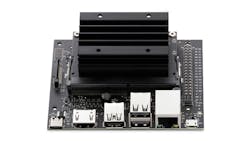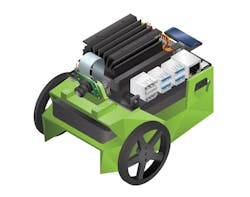Nvidia made quite a splash with the Jetson Nano. At $99, it delivers a 64-bit, quad-core Arm processing complex with a 128-core Nvidia Maxwell GPGPU. The latter allows the system to handle heavy-duty machine learning (ML). The original version had 4 GB of DRAM on the module.
Now there’s a 2-GB version priced at $59 (Fig. 1). This brings it in direct competition with lower-cost platforms like the Raspberry Pi and Arduino. Keep in mind that the Raspberry Pi 4 with 4 GB of DRAM costs about the same, but it’s really Nvidia’s GPGPU that makes the system hum.
If you’re looking for a platform to learn about machine learning, then the Jetson Nano 2GB is going to be a bargain. It works with the same Nvidia JetPack SDK that supports the entire family, which highlights another advantage of the Jetson Nano—scalability. It’s plug-compatible with the Jetson Xavier NX, and both are functionally compatible with the Jetson AGX Xavier. There are even more power Nvidia platforms that will support software developed for the compact Jetson Nano.
The same CUDA-X accelerated computing stack works on all platforms. Nvidia built a lot of software on this platform from the Isaac robot platform to the company’s many smart car platforms. The software supports all popular ML platforms such as TensorFLow, PyTorch, Caffe, and MxNet.
I’ve only had a couple days working with the 2-GB version of the Jetson Nano, but it’s on par with what I did using the earlier 4-GB version. It pairs down the USB ports to one USB 3.0 and three USB 2.0 ports (two Type A and one Micro-B). A USB dongle provide Wi-Fi support. There’s also a single CSI-2 camera interface. The carrier board for the development kit reflects these changes. This video shows how to get started with Jetson Nano 2GB:
The interesting thing about the Jetson Nano 2GB is that the demos and tutorials worked just fine even though they were targeted for the 4-GB version. Nvidia expanded the number of tutorials and applications as well. It supports the container runtime, which simplifies tools, demos, etc., plus it’s compatible with the other Nvidia hardware as mentioned earlier. Most of the projects are on GitHub, ranging from a real-time human pose estimation to an AI Thermometer based on a Raspberry Pi Camera module and a FLIR Lepton 3.5 Thermal Camera Module.
Because the latest module is plug-compatible with the original and Xavier NX, it works with the open-source JetBot AI robot platform (Fig. 2) as well as a host of carrier boards from third parties. The module format is popular and supported by platforms like Gumstix’s Geppetto for creating custom carrier boards.
The Jetson Nano 2GB is obviously targeting STEM, where keeping costs down is critical. The module is currently available only in kit form, unlike the $99 4-GB version. Of course, large quantities can be obtained for a discounted price. There may not be as much of a price difference because some of the cost-cutting occurred on the carrier board.
About the Author
William G. Wong
Senior Content Director - Electronic Design and Microwaves & RF
I am Editor of Electronic Design focusing on embedded, software, and systems. As Senior Content Director, I also manage Microwaves & RF and I work with a great team of editors to provide engineers, programmers, developers and technical managers with interesting and useful articles and videos on a regular basis. Check out our free newsletters to see the latest content.
You can send press releases for new products for possible coverage on the website. I am also interested in receiving contributed articles for publishing on our website. Use our template and send to me along with a signed release form.
Check out my blog, AltEmbedded on Electronic Design, as well as his latest articles on this site that are listed below.
You can visit my social media via these links:
- AltEmbedded on Electronic Design
- Bill Wong on Facebook
- @AltEmbedded on Twitter
- Bill Wong on LinkedIn
I earned a Bachelor of Electrical Engineering at the Georgia Institute of Technology and a Masters in Computer Science from Rutgers University. I still do a bit of programming using everything from C and C++ to Rust and Ada/SPARK. I do a bit of PHP programming for Drupal websites. I have posted a few Drupal modules.
I still get a hand on software and electronic hardware. Some of this can be found on our Kit Close-Up video series. You can also see me on many of our TechXchange Talk videos. I am interested in a range of projects from robotics to artificial intelligence.



